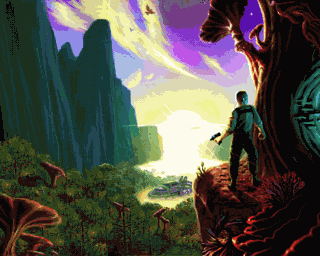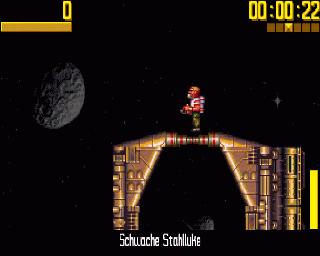Exile Tribute: The CD32 version

The artwork from the AGA and CD32 version>

The artwork from the AGA and CD32 version>
I have very little information regarding this version of the game so any further facts, comments or even files would be welcome. I understand that the game would be very similar to the A1200 version as essentially, this was the Amiga architecture which was used for the console. Certain differences did exist in the game and its development of which I am aware, so please read on...
The CD32 was a console in contrast to the computers to which all other versions had been ported. I am told the probable reason for the release of Exile on this platform was that the CD32 was essentially an Amiga 1200 in console form and probably it was deemed that this could extend the potential market for the game without too much effort (although in reality there was quite a challenge re-configuring the graphics). The CD32 ran games on compact disc and as might be expected required minimal user input apart from the game playing devices ˜ joysticks etc. Audiogenic inform me that the CD32 version is no longer available unfortunately.
However, Peter and Jeremy enlisted the help of an Exile fan, Tony Cox, in order to convert to this platform as they had done with William Reeve for the 16-bit conversions.
I have recently been able to contact Tony Cox and he was kind enough to provide me with some memories of his involvement in Amiga Exile which I am grateful for. It was the first project of his career.
Moreover, the CD32 version is apparantly quite distinct from any other version in that the graphics were intentionally made 50% larger and the process of implementing this proved to be tricky. Peter recalls the difficult process of performing double compressions of the game data:
the CD32 version was 50% zoomed in because, being a console, the player was further from the screen and it was deemed that they couldn't make out details easily enough. This caused unpredicted programming problems mainly to do with dividing coordinates by 3, and thus smooth motion became a problem to solve! Also the game save had to be highly compressed to fit in the limited ram store of the CD32. We had to manually consider each piece of data that had to be saved, work out how many bits were significant, and store this in a bit stream to a buffer, then compress that with further algorithms - doing the reverse for loading from game store.
Tony adds to this, making a point about the console control changes as mentioned above:
For the CD32 we had to come up with a game save system that would work on the tiny memory available. The game state was pretty large, since you could essentially wander the whole map, so I came up with a system of the game having a number of pre-cooked 'snapshots' of state at various stages of play - it would pick the closest one and store the differences between your state and that snapshot, which would hopefully be small enough to compress down into the space available. We also had to map all the (numerous) keyboard controls to the CD32 controller - pretty tricky, but I think we got there eventually.
It's interesting to hear that memory became limited as it did on the BBC version but as Tony indicated elsewhere, the Amiga versions used a tiling system to form the map as opposed to what I understand to be a series of calculations on the original.
Here will be placed further screenshots in addition to those elesewhere in the Amiga section to illustrate the CD32 version of the game.

Finn on top of the central chamber of the Pericles (a source of grenades in the original BBC Micro version).
Back to Exile tribute index page
Last modified 09/04